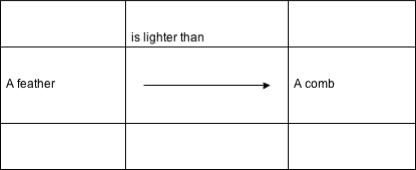1. Doing practical work in groups
Estimation is an important skill in both mathematics and science. Simple balances (which can be made with very modest resources) allow pupils to approach measuring and estimating weight through practical investigation.
You may like to make simple balances and plan and carry out these activities jointly with a science teacher in your school. This will help pupils see the link between subjects.
Case Study 1: Estimating weight
Mrs Nwadike in Uganda was on a teachers’ course at her local district offices. As part of the day’s lesson on numeracy, the facilitator told the following story to them. Then she asked the teachers what they thought the girls knew and what would they do next with these pupils if they were in their class.
‘Two girls, Ronke and Ade, were discussing the quantity of popcorn in two packets, A and B, which looked the same shape and size. Ronke picked up the packets one after the other and was surprised that B felt heavier than A. She told Ade that B appeared to be heavier than A. Ade decided to put the two packets in the two pans of a simple balance (see Resource 1). She observed that, on the scale, packet B went down and so B is heavier than A. Ronke was right.’
The teachers worked in pairs, devising activities that encouraged estimation of heavier/lighter, then using a balance or scales to test their ideas. Each pair tried their lesson out with their classes and reported back next session.
Mrs Nwadike found that her class enjoyed the lesson but that she did not have enough different objects for the pupils to use (for advice on collecting objects, see Key Resource: Being a resourceful teacher in challenging circumstances [Tip: hold Ctrl and click a link to open it in a new tab. (Hide tip)] ). She said that next time she would spend more time collecting objects and she would use smaller groups of four to six rather than over ten in each group.
Activity 1: Comparing weight
You will need five simple balances (see Resource 1) to carry out this activity and five sets of common objects e.g. stones, balls, tins, bottle tops etc. that could be used with the balances. These can be collected from around the school.
Write instructions for your pupils on the board (see Resource 2: Pupil instructions for estimating and comparing weights) and show the class what you want them to do using any two objects.
- Give two objects to two pupils and ask them to estimate which object is heavier.
- Now ask a pupil to test their idea out by putting the objects on the pan.
- Ask them which is the heaviest object, and why they think so.
Organise your pupils into five groups, giving each group a set of objects and a balance. Ask pupils to find which object is heavier by estimating its weight and then by using the balance. (See Key Resource: Using group work in your classroom.) Ask them to fill in a table of their results to share with the class to see if everyone agrees.
You could challenge older or more able pupils to see if they can order their objects from heaviest to lightest before testing. They could use a table like the one below. How could they test their answers using the simple balance?

Section 4: Working with weight



